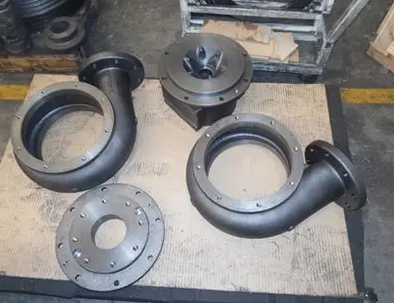Water pump body processing process
The process flow of pump body processing is a complex process involving multiple steps, mainly including raw material preparation, rough processing, fine processing, heat treatment, assembly and debugging, and quality inspection. The following is a detailed description of these links:
1. Raw material preparation
Material selection: According to the performance requirements and use conditions of the water pump, select suitable materials, such as cast iron, stainless steel, copper, aluminum, etc. These materials must have good mechanical properties and corrosion resistance.
Material inspection: Quality inspection of the selected materials to ensure that they meet the design requirements, including material composition, hardness, toughness and other performance indicators.
2. Rough processing
Cutting and blanking: Use cutting machines and other equipment to cut the raw materials into the approximate shape and size required for the pump body.
Preliminary forming: Through casting, forging or welding, the raw materials are preliminarily processed into the basic shape of the pump body.
3. Finishing
Boring and milling: Use boring machines, milling machines and other equipment to finish the pump body to ensure that the key parts of the pump body such as the flow channel and hole position meet the design requirements. Accuracy and surface roughness.
Drilling and tapping: According to the design requirements of the pump body, drill holes and tap at designated locations to facilitate the installation of bolts and other fasteners during subsequent assembly.
4. Heat treatment
Annealing and normalizing: Annealing is used to eliminate the internal stress generated by the pump body material during processing and improve the plasticity and toughness of the material; normalizing is used to refine the grains and improve the strength and hardness of the material.
Quenching and tempering: For the parts of the pump body that need to improve hardness and wear resistance, quenching treatment is performed; followed by tempering treatment to eliminate the internal stress and brittleness generated by quenching.
5. Assembly and debugging
Parts cleaning: Clean the various parts of the pump body before assembly to remove oil and impurities.
Assembly: Assemble the various parts of the pump body according to the design requirements, including key parts such as impellers, bearings, and shafts. During the assembly process, the relative position and matching accuracy of the parts need to be strictly controlled.
Debugging: After assembly, debugging work is carried out, including static and dynamic tests. The static test mainly checks the sealing and tightness of the pump body; the dynamic test simulates the actual working conditions to check whether the performance parameters of the pump body meet the design requirements.
VI. Quality Inspection
Appearance inspection: Check the appearance quality of the pump body, including surface finish, paint quality, etc.
Dimension inspection: Use measuring tools to inspect the key dimensions of the pump body to ensure that it meets the design requirements.
Performance inspection: Use flow testing, pressure testing and other methods to check whether the performance parameters of the pump body meet the design requirements.





